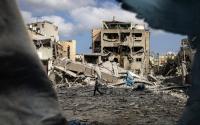17 Nisan 2006History News NetworkLawrence S. Wittner
Dr. Wittner is Professor of History at the State University of New York, Albany. His latest book is Toward Nuclear Abolition: A History of the World Nuclear Disarmament Movement, 1971 to the Present (Stanford University Press).
In 2005, U.S. Secretary of Defense Donald Rumsfeld, recognizing that the Bush administration's favorite new nuclear weapon--the "Bunker Buster"--was on the road to defeat in Congress, told its leading antagonist, U.S. Representative David Hobson (R-Ohio): "You may win this year, but we'll be back."
And, now, like malaria or perhaps merely a bad cold, they are.
The Bush administration's latest nuclear brainchild is the Reliable Replacement Warhead (RRW). According to an April 6, 2006 article in the Los Angeles Times (Ralph Vartabedian, "U.S. Rolls Out Nuclear Plan"), the RRW, originally depicted as an item that would update existing nuclear weapons and ensure their reliability, "now includes the potential for new bomb designs. Weapons labs currently are engaged in design competition."
Moreover, as the Times story reported, the RRW was part of a much larger Bush administration plan, announced the previous day, "for the most sweeping realignment and modernization of the nation's system of laboratories and factories for nuclear bombs since the end of the Cold War." The plan called for a modern U.S. nuclear complex that would design a new nuclear bomb and have it ready within four years, as well as accelerate the production of plutonium "pits," the triggers for the explosion of H-bombs.
Although administration officials justify the RRW by claiming that it will guarantee the reliability of the U.S. nuclear weapons stockpile and reduce the need for nuclear testing, arms control and disarmament advocates are quite critical of these claims. Citing studies by Lawrence Livermore National Laboratory researchers, they argue that U.S. nuclear weapons will be reliable for decades longer than U.S. officials contend. Furthermore, according to Hoover Institution fellow Sidney Drell and former U.S. Ambassador James Goodby: "It takes an extraordinary flight of imagination to postulate a modern new arsenal composed of such untested designs that would be more reliable, safe and effective than the current U.S. arsenal based on more than 1,000 tests since 1945." Thus, if new nuclear weapons were built, they would lead inevitably to the resumption of U.S. nuclear testing and, thereby, to the collapse of the moratorium on nuclear testing by the major nuclear powers and to the final destruction of the Comprehensive Test Ban Treaty.
Most worrisome for nuclear critics, however, is the prospect that the administration will use the RRW program to develop new kinds of nuclear weapons. Daryl Kimball, executive director of the Arms Control Association, remains convinced that the replacement process initiated by the RRW program could serve as a back door to such development. Peace Action, the nation's largest peace and disarmament organization, maintains that "the weapons labs and the Department of Defense will be the ones to decide the real scope" of the RRW program.
Even Representative Hobson, who seems to favor the RRW, appears worried that the administration has a dangerously expansive vision of it. "This is not an opportunity to run off and develop a whole bunch of new capabilities and new weapons," he has declared. "This is a way to redo the weapons capability that we have and maybe make them more reliable." Hobson added: "I don't want any misunderstandings . . . and sometimes within the [Energy] department, people hear only what they want to hear. . . . We're not going out and expanding a whole new world of nuclear weapons."
Certainly, some degree of skepticism about the scope of the program seems justified when one examines the Bush administration's overall nuclear policy. Today, despite the U.S. government's commitment, under the nuclear Non-Proliferation Treaty (NPT) of 1968, to divest itself of nuclear weapons through negotiated nuclear disarmament, the U.S. nuclear stockpile stands at nearly 10,000 nuclear warheads, with more than half of them active or operational.
Not only does the Bush administration steer clear of any negotiations that might entail U.S. nuclear disarmament, but it has pulled out of the ABM treaty and refused to support ratification of the Comprehensive Test Ban Treaty (negotiated and signed by former President Bill Clinton). According to the Defense Department's Quadrennial Defense Review Report of February 2006, "a robust nuclear deterrent . . . remains a keystone of U.S. national power."
Furthermore, there are clear signs that the Bush administration is shifting away from the traditional U.S. strategy of nuclear deterrence to a strategy of nuclear use. The nuclear Bunker Buster, for example, was not designed to deter aggression, but to destroy underground military targets. Moreover, in recent years, the U.S. Strategic Command has added new missions to its war plans, including the use of U.S. nuclear weapons for pre-emptive military action. Seymour Hersh's much-cited article in the New Yorker on preparations for a U.S. military attack upon Iran indicates that there has already been substantial discussion of employing U.S. nuclear weapons in that capacity.
This movement by the Bush administration toward a nuclear buildup and nuclear war highlights the double standard it uses in its growing confrontation with Iran, a country whose nuclear enrichment program is in accordance with its NPT commitments. Of course, Iran might use such nuclear enrichment to develop nuclear weapons--and that would be a violation of the NPT. But Bush administration policies already violate U.S. commitments under the treaty, and this fact appears of far less concern to Washington officialdom. Logic, however, does not seem to apply to this issue--unless, of course, it is the logic of world power.






